|
Equipment and Software Tools |
 |
|
Note - this section will be significantly expanded during the coming months to provide more details and suggested strategies. What follows is a simple summary. ~HL There is an enormous range of possibilities for cameras, lights, microphones, and storage devices. Here we simply document our choices and selection as a potential model for other similar projects. The entire video capture process can in fact be completed with a simple digital video camera using it's built-in microphone and natural lighting. This depends on the nature of the project, intended purpose and audience, and available equipment and budgets. Given the scope and permanence of Telling Their Stories, we chose equipment at the lower end of the professional scale. The criteria for equipment choices include: portability, ease of set-up, quality of recording, and price. Camera
Approximate cost: $3000
Approximate cost: $2000 This is mounted on a Bogen tripod with fluid head for smoother panning and tilt. Approximate cost: $2000 (camera) $200 (tripod and
head) Tripod
Lighting
1- single Lowel Rifa-lite 55 along with the optional "egg-crate" that helps direct the light on the subject. This is costly - roughly $450 - but has many advantages over less expensive lights including: very fast set-up and take-down as this folds into an umbrella-like size; the bulb cools down very quickly for faster exit; and the bulb is quieter than others we've used.
In the past we've used other box lights as well as an umbrella reflector. A decent box light is far superior to a less expensive umbrella light in their ability to control the light. The least expensive "second light" is a sheet of white foam-core board placed on a music stand. If using foam core, one trick is to slice it half-way through one side in parralel thirds, allowing you to fold the board into 3rds. Use white fabric or gaffer's tape to seal of the creases and this can last for years. Click image to see larger view: Microphone
Digital Storage We record SIMULTANEASLY to mini-dv tape AND to a computer. The mini-dv tape essentially becomes the back-up - when all works well, we never have to go to tape, but instead access everything via hard-drives. This accomplishes: intanantaneous back-up, immediate access to the movie, and ease of distribution. The Canons have NOT been successful in direct recording to an external hard-drive - thus we record to a computer directly and then transfer to an external drive after the interview. We've used several external drives over the years, some removable drive-trays systems and some stand alone drives. We now use 1TB 7200 Firewire drives with a combination of USB, Firewire 400 and Firewire 800 ports. A Maxtor 1TB drive is now approx. $300 and will hold approx 70 hours of full dv. Figure that 1 hour of video will take up approximately 15GB. Approximate cost for drives: $.30/GB, i.e., $300/1TB Computers All computer work is completed on dv capable Apple MacBooks. During year 1, students had access to laptops during class time and were able to check them out at night for additional work. During the past 5 years, students have hadtheir own school assigned Apple MacBook at all times. Software Apple iMovie is used solely to import
video - it is not used for editing. |
|
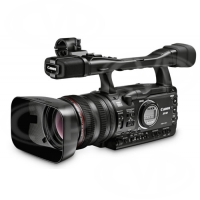 We currently use the new Canon XH-A1. This is a "High Definition" camera that provides the option of shooting in HD in the future, though this is currently used only in standard 4:3 mode. The primary rationale of moving up to this camera from the GL series is it's far better zoom speed controller and native XLR audio inputs. The key frustration in the past in a tight interview set-up is that the Canon GLs zoom more abruptly and have no lens-based manual zoom. The XH-A1 provides both on-lens manual zoom and a 16 step adjustable zoom.
We currently use the new Canon XH-A1. This is a "High Definition" camera that provides the option of shooting in HD in the future, though this is currently used only in standard 4:3 mode. The primary rationale of moving up to this camera from the GL series is it's far better zoom speed controller and native XLR audio inputs. The key frustration in the past in a tight interview set-up is that the Canon GLs zoom more abruptly and have no lens-based manual zoom. The XH-A1 provides both on-lens manual zoom and a 16 step adjustable zoom.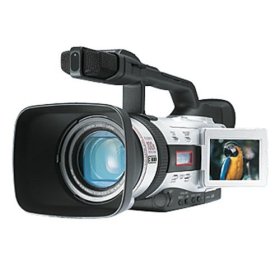 The Canon GL2 has been used for the past 3 years with excellent results. This gives superior results
over a less expensive consumer model, both in sound and video quality for far less than the XH-A1.
The Canon GL2 has been used for the past 3 years with excellent results. This gives superior results
over a less expensive consumer model, both in sound and video quality for far less than the XH-A1.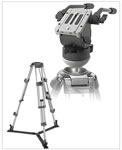 We currently use a Dynatran AT 9903 tripod and head. This is quite large, arguably far too large for the Canon GLs - but was picked up for approx. $300 on EBay. It's rock solid and has a true professional feel.
We currently use a Dynatran AT 9903 tripod and head. This is quite large, arguably far too large for the Canon GLs - but was picked up for approx. $300 on EBay. It's rock solid and has a true professional feel.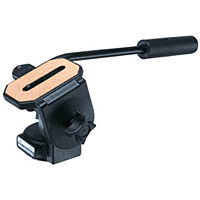 In the past we have used a Bogen tripod. A 3126 Micro Fluid Head paired with one of many tripod legs costs roughly $200.
In the past we have used a Bogen tripod. A 3126 Micro Fluid Head paired with one of many tripod legs costs roughly $200. 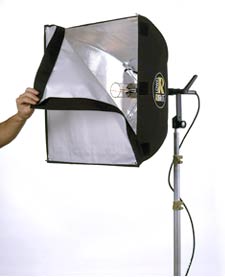 We use a simple "two-light" system composed of:
We use a simple "two-light" system composed of: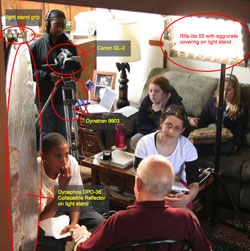
 A single lavaliere mic (Audio-Technica
A single lavaliere mic (Audio-Technica